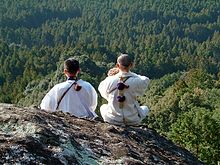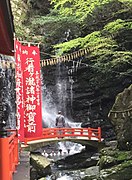Shugendō



Shugendō (修験道, lit. the "Way [of] Trial [&] Practice", the "Way of Shugen, or Gen-practice"[1]) is a highly syncretic religion, a body of ascetic practices that originated in Heian-era Japan, having evolved during the 7th century from an amalgamation of beliefs, philosophies, doctrines and ritual systems drawn from local folk-religious practices, Shinto mountain worship and Buddhism. The final purpose of Shugendō is for practitioners to find supernatural power and save themselves and the masses by conducting religious training while treading through steep mountain ranges. Practitioners are called Shugenja (修験者) or Yamabushi (山伏, literally "Mountain Prostrator").[2]
The mountains where Shugenja practiced were all over Japan, and among them, the Ōmine mountain range, which stretches 100 km from north to south and connects Yoshino and Kumano, was historically the biggest practice place of Shugendō. The highest peak of the Ōmine mountain range is Mount Hakkyō at an altitude of 1915 m, and there are 75 places for ascetic practices along the mountain trail, and Ōminesan-ji Temple at the top of Mount Ōmine at an altitude of 1719 m is considered to be the highest sacred site of Shugendō. At present, the Ōmine mountain range is designated as a UNESCO World Heritage Site "Sacred Sites and Pilgrimage Routes in the Kii Mountain Range" and Yoshino-Kumano National Park. The object to be worshipped by Shugenja is Gongen (権現), which was born from the syncretism of Shinto and Buddhism, and Zaō Gongen (蔵王権現) is considered the most important among them.[2][3]
History[]
Shugendō evolved during the seventh century from an amalgamation of beliefs, philosophies, doctrines and ritual systems drawn from local folk-religious practices, Shinto mountain worship and Buddhism.[2][4] The seventh-century ascetic and mystic En no Gyōja is widely considered as the patriarch of Shugendō, having first organized Shugendō as a doctrine. Shugendō literally means "the path of training and testing" or "the way to spiritual power through discipline."[5][6]
From the ninth century, elements of Vajrayana Buddhism such as Shingon and Tendai Buddhism were taken into Shugendō and it developed further.[2] In the Heian period, it became very popular among the nobles living in Kyoto to visit Kumano Sanzan (three major shrines, Kumano Hongū Taisha, Kumano Hayatama Taisha and Kumano Nachi Taisha), which was the common holy place of Shugendō, Shinto and Buddhism.[7]
The Meiji government, which erected a barrier between Shinto and Buddhism, ruled that Shugendō was unacceptable because of its amalgamation of the two religions, and officially forbade it in 1872. With the advent of religious freedom in Japan after World War II, Shugendō was revived.[1]
In modern times, Shugendō is practiced mainly through Tendai and Shingon temples. Some temples include Kimpusen-ji in Yoshino (Tendai), Ideha Shrine in the Three Mountains of Dewa and Daigo-ji in Kyoto (Shingon).[2] Shugendō practitioners are said to be descendants of the Kōya Hijiri monks of the eighth and ninth centuries.[8]

Shugenja model in the Shugendō-Museum of the Shippōryū-ji-Temple (Osaka prefecture)

Ascetic waterfall exercise supervised by a monk (Shippōryū-ji Temple)
See also[]
References[]
- ^ Jump up to: a b Catherine Cornille (2013). The Wiley-Blackwell Companion to Inter-Religious Dialogue. John Wiley & Sons. ISBN 9781118529942.
- ^ Jump up to: a b c d e "修験道とは・・・「自然と人間」". Tendaijimon Sect. Retrieved 31 January 2021.
- ^ Masayasu Oda. "The Formation and its Meaning of the 75-sacred-place View in the Omine Sacred Mountain Area". Retrieved 2 February 2021.
- ^ Kornicki, P.F.; McMullen, I. J. (1996). Religion in Japan: Arrows to Heaven and Earth (Reprint ed.). Cambridge: Cambridge University Press. pp. 13-. ISBN 9780521550284. Retrieved 11 March 2017.
- ^ Picken, Stuart D.B. (1994). Essentials of Shinto: An Analytical Guide to Principal Teachings. Westport, Connecticut: Greenwood Press. p. 99. ISBN 0313264317.
- ^ Blacker, Carmen (2000). "16: Initiation in the Shugendō: the Passage Through the Ten States of Existence". Collected Writings of Carmen Blacker. Richmond, Surrey: Japan Library. pp. 186–199. ISBN 9781873410929.
- ^ Makoto Satō, Fumihiko Gomi, Toshihiko Takano and Yasushi Toriumi (30 August 2008). 詳説日本史研究. Yamakawa Shuppansha Ltd. ISBN 9784634011014.CS1 maint: multiple names: authors list (link)
- ^ Blacker, Carmen (1999). The Catalpa Bow: A Study of Shamanistic Practices in Japan (3rd ed.). Richmond: Japan Library. pp. 165–167. ISBN 1873410859.
Bibliography[]
- Faure, Bernard; Moerman, Max; Sekimori, Gaynor (2011). Shugendō: The History and Culture of a Japanese Religion. Kyoto: Ecole française d'Extrême-Orient, centre de Kyoto. ISBN 9782855391236.
- Gill, Andrea K. (2012). "Shugendō: Pilgrimage and Ritual in a Japanese Folk Religion". Pursuit - The Journal of Undergraduate Research at the University of Tennessee. 3 (2): 49–65. ISSN 2330-4715. Retrieved 11 October 2017.
- Hitoshi, Miyake; Sekimori, Gaynor (2005). The Mandala of the Mountain: Shugendō and Folk Religion (1st ed.). Tokyo: Keio University Press. ISBN 9784766411287.
- Miyake, Hitoshi (1989). "Religious Rituals in Shugendo: A Summary". Japanese Journal of Religious Studies. 16 (2/3): 101–116. doi:10.18874/jjrs.16.2-3.1989.101-116. JSTOR 30234003.
External links[]
This section's use of external links may not follow Wikipedia's policies or guidelines. (December 2016) |
- A Look at Japanese Ascetic Practice
- Head Temple Takao-san Yakuo-in Central Shugendo Training Center in Kanto
- 天台寺門宗|修験道
- 古流修験本宗|Koryu Shugen Honshu website for the Mt. Koshikidake tradition of Shugendo.
- 国際修験道協会|International Shugendo Association the overseas outreach of Koryu Shugen Honshu.
- Shugen: The Autumn Peak of Haguro Shugendo
- Mount Fuji and Shugendo
- Shugendo article in Buddhism & Shintoism in Japan: A-to-Z Photo Dictionary of Japanese Religious Sculpture & Art
- Shugendo - History of Japan Database
- Shugendō
- Religion in Japan
- Religious syncretism in Japan
- Shinbutsu shūgō
- Vajrayana

